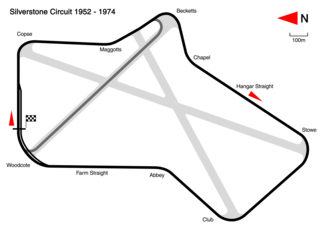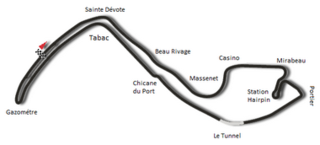
The Albert Park Circuit is a motorsport street circuit around Albert Park Lake, three kilometres south of central Melbourne. It is used annually as a circuit for the traditional Formula One season-opening Australian Grand Prix, the supporting Supercars Championship Melbourne 400 and other associated support races. The circuit has an FIA Grade 1 license. Although the entire track consists of normally public roads, each sector includes medium to high-speed characteristics more commonly associated with dedicated racetracks facilitated by grass and gravel run-off safety zones that are reconstructed annually. However, the circuit also has characteristics of a street circuit's enclosed nature due to concrete barriers annually built along the Lakeside Drive curve, in particular, where run-off is not available due to the proximity of the lake shore.

The 1950 British Grand Prix, formally known as The Royal Automobile Club Grand Prix d'Europe Incorporating The British Grand Prix, was a Formula One motor race held on 13 May 1950 at the Silverstone Circuit in Silverstone, England. It was the first World Championship Formula One race, as well as the fifth British Grand Prix, and the third to be held at Silverstone after motor racing resumed after World War II. It was the first race of seven in the 1950 World Championship of Drivers.

The 1952 Swiss Grand Prix was a Formula Two race held on 18 May 1952 at Bremgarten Circuit. It was the first round of the 1952 World Championship of Drivers, in which each Grand Prix was run to Formula Two rules rather than the Formula One regulations normally used.

The 1952 French Grand Prix was a Formula Two race held on 6 July 1952 at Rouen-Les-Essarts. It was race 4 of 8 in the 1952 World Championship of Drivers, in which each Grand Prix was run to Formula Two rules rather than the Formula One regulations normally used. Unusually this race was run over a duration of 3 hours, rather than a fixed distance.

The 1952 British Grand Prix was a Formula Two race held on 19 July 1952 at Silverstone Circuit. It was race 5 of 8 in the 1952 World Championship of Drivers, in which each Grand Prix was run to Formula Two rules rather than the Formula One regulations normally used.

The 1956 Argentine Grand Prix was a Formula One motor race held on 22 January 1956 at Buenos Aires. It was race 1 of 8 in the 1956 World Championship of Drivers.

The 1957 Argentine Grand Prix was a Formula One motor race held on 13 January 1957 at the Buenos Aires circuit. It was race 1 of 8 in the 1957 World Championship of Drivers.

The 1958 Argentine Grand Prix was a Formula One motor race held on 19 January 1958 at Autodromo Municipal Ciudad de Buenos Aires Circuit. It was race 1 of 11 in the 1958 World Championship of Drivers and race 1 of 10 in the 1958 International Cup for Formula One Manufacturers. The race was the sixth Argentine Grand Prix. It was held on the #2 variation of the circuit. The race was held over 80 laps of the four kilometre circuit for a total race distance of 313 kilometres.

The 1958 Monaco Grand Prix was a Formula One motor race held on 18 May 1958 at Monaco. It was race 2 of 11 in the 1958 World Championship of Drivers and race 2 of 10 in the 1958 International Cup for Formula One Manufacturers. The race was the 16th Monaco Grand Prix and was held over 100 laps of the three kilometre circuit for a total race distance of 314 kilometres.

The 1959 French Grand Prix was a Formula One motor race held at Reims on 5 July 1959. It was race 4 of 9 in the 1959 World Championship of Drivers and race 3 of 8 in the 1959 International Cup for Formula One Manufacturers. It was the 37th French Grand Prix and the twelfth to be held at the Reims highway circuit and the fourth to be held on the longer and faster 8.348 km layout. The race was held over 50 laps of the eight kilometre circuit for a race distance of 417 kilometres.
The 1957 Formula One season was the 11th season of FIA Formula One motor racing. It featured the 1957 World Championship of Drivers which commenced on 13 January 1957 and ended on 8 September after eight races. Juan Manuel Fangio won his fourth consecutive title, his fifth in total, in his final championship. A feat that would not be beaten until Michael Schumacher in 2003. The season also included numerous non-championship races for Formula One cars.
The 1952 Formula One season was the sixth season of FIA Formula One motor racing. In comparison to previous seasons, the 1952 season consisted of a relatively small number of Formula One races, following the decision to run all the Grand Prix events counting towards the World Championship of Drivers to Formula Two regulations rather than Formula One. The Indianapolis 500, which also counted towards the World Championship, was still run to AAA regulations as in previous seasons.

The 1951 Formula One season was the fifth season of FIA Formula One motor racing. It featured the 1951 World Championship of Drivers, which commenced on 27 May 1951 and ended on 28 October after eight races. The season also included 14 races that were open to Formula One cars but did not count towards the championship standings.

The Swedish Grand Prix was a round of the Formula One World Championship from 1973 to 1978. It took place at the Scandinavian Raceway in Anderstorp, about 30 kilometres (19 mi) from Jönköping, in Småland, Sweden. The first race to hold the title of Grand Prix in Sweden was the Swedish Winter Grand Prix, an ice race similar to races held in Estonia, Finland and Norway. The first Swedish Summer Grand Prix was held in 1933, but was not repeated until 1949.

Jean Marie Behra was a Formula One driver who raced for the Gordini, Maserati, BRM, Ferrari and Porsche teams.
David Alan Hampshire was a British racing driver from England. He was born in Mickleover, Derbyshire and died in Newton Solney, in South Derbyshire.

Reginald Parnell was a racing driver and team manager from Derby, England. He participated in seven Formula One World Championship Grands Prix, achieving one podium, and scoring a total of nine championship points.

The Cooper T51 was a Formula One and Formula Two racing car designed by Owen Maddock and built by the Cooper Car Company for the 1959 Formula One season. The T51 earned a significant place in motor racing history when Jack Brabham drove the car to become the first driver to win the World Championship of Drivers with an engine mounted behind them, in 1959. The T51 was raced in several configurations by various entrants until 1963 and in all no less than 38 drivers were entered to drive T51s in Grand Prix races.

The 1950 Jersey Road Race was a Non-Championship Formula One motor race held on 9 July 1950 at the St. Helier Circuit, in Saint Helier, Jersey. It was the twelfth race of the 1950 Formula One season. The 55-lap race was won by Ferrari driver Peter Whitehead. Reg Parnell finished second in a Maserati, and Toulo de Graffenried third, also in a Maserati.
The 1956 Argus Trophy was a Formula Libre motor race held at the Albert Park Circuit in Victoria, Australia on 18 March 1956. The race was contested over 48 laps, a total distance of 150 miles. It was staged by the Light Car Club of Australia as the feature event on the second Sunday of the two-day "Moomba Meeting", which was held with the co-operation of the Moomba Festival organisers.















